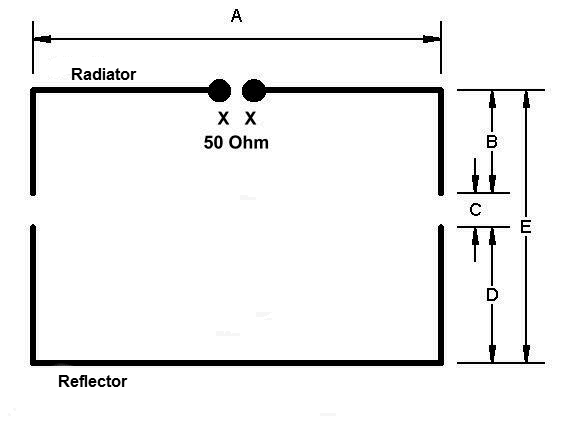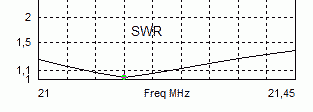The Moxon-Beam was introduced by L. Moxon (G6XN) in his book "HF Antennas for all Locations" (RSGB- Publications, Great Britain 1993). This beam is a 2-Element-Yagi with radiator and reflector and reduced size to about 75% of a normal beam. The 2-Element-Yagi with reflector has normally a 0,2-lambda-boom and an impedance of 50 W. The Moxon-beam has a 0,18-lambda-boom and still 50 Ohm. This is a good impedance for wire- beams.The ends of the two elements are bended backward (radiator) or forward (reflector) and act as a capacitive load. That is much better than inductive loading with coils. So we have greater bandwidth and lower losses.Through the reduced size we get a 0,5-0,7 dB lower gain than with a fullsize beam.

This type of a 2-Element-Yagi has an unbelievable F/B-ratio on the design frequency of >= 30 dB. That is higher than with any other 2-Element-Beam.
The gain is higher on the beginning of the band and lower at the end. The bandwidth for a SWR < 1,5 is great enough for the range of 28,0-28,7 and 21,0-21,45 MHz if the beam is built up with aluminium tubes. Wire-beams of the Moxon-type have a smaller bandwidth.
The design frequency should be for a frequency 1/3 from the beginning of the band, because the SWR raises more below the design frequency. For example look for the SWR of a tube-Moxon for the 15-m-band:

Designing a Moxon- Beam is very easy with a useful little program by D. Maguire, AC6LA with the name "Moxgen".
This freeware can be downloaded at:
Moxgen generates an output file for "EZNEC" for modifications (e.g tapering) and shows you the dimensions for building a wire-Moxon.
No comments:
Post a Comment